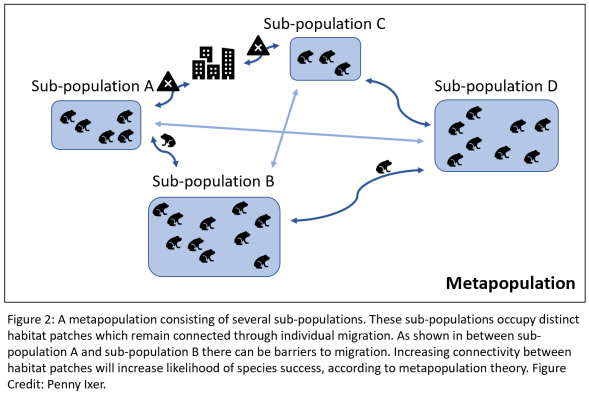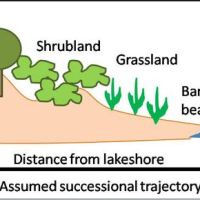Application of the Metapopulation Theory to Conservation:
Posted: April 12, 2019 | Author: 3Rs in Ecology | Filed under: 2019, ERES525, Module Critique Assignment, Uncategorized | Tags: conservation, fragmentation, metapopulation theory, metapopulations |Leave a commentPenny Ixer:
Abstract:
As urbanization intensifies on a global scale, species habitats and populations are becoming increasingly fragmented. This module will investigate the potential application of the metapopulation theory to the conservation of fragmented species. Theory is established as a way to develop understanding of key phenomenon and processes, and hence may enhance conservation strategies. This module determines how the metapopulation theory may be applied to conservation of fragmented species, providing a framework for understanding species population dynamics. Delivering a series of predictions consistent with the population dynamics of fragmented species, the module determines how the metapopulation theory may guide conservation efforts. The key predictions of the metapopulation theory suggest the conservation of fragmented species should focus on conserving species in large habitat patches, with high connectivity. A case study supporting the application of the metapopulation theory to the conservation of fragmented species, examined the fit between the metapopulation theory and population dynamics of amphibians in a highly fragmented urban landscape. The module will further describe several criticisms of the metapopulation theory, determining the theory’s applicability to large mammals, the assumption that habitats do not change in suitability, and the assumption that sub-populations have constant extinctions and colonizations, as factors which may limit its applicability to conservation. Despite its criticisms, the metapopulation theory may provide a fundamental tool to aiding the conservation of fragmented species.
Introduction:
As urban settlements continuously expand, environments are becoming increasingly fragmented (Verhoef & Morin, 2009). Fragmentation occurs when continuous habitats are destroyed and become represented by spatially separate habitat patches (Hanski, 2004), as illustrated by figure 1. The fragmentation of species habitat and populations potentially threatens biodiversity by preventing migration between sub-populations and reducing genetic diversity (Foster et al., 2017). The application of theory may enhance conservation strategies regarding the fragmentation of species.

Theory advances understanding of key phenomenon and processes. Applying hypotheses, notions and generalizations to situations, theory may become a powerful tool to aid the conservation of biodiversity (Hanski, 2004). Paired with models, theory can and has been successfully utilized in conservation (Hanski, 2004).
Metapopulation theory may provide a framework for understanding species population dynamics, which could in turn be applied to the conservation of fragmented species. This module will investigate metapopulation theory, its predictions, and how it may be applied to the conservation of fragmented species. To build a case for the use of metapopulation theory in conservation, the module will further examine the population dynamics of amphibians in an urban landscape. Criticisms of metapopulation theory will also be considered to determine the theory’s potential application to conservation.
Metapopulation Theory:
A metapopulation consists of a set of sub-populations, occupying distinct habitat patches and connected through the dispersal, migration or human-mediated movement of individuals between patches (Young, 1999; Foster et al., 2017), as shown by Figure 1. Emerging in the 1960’s, the metapopulation theory describes how species population dynamics are affected by spatially distant habitats (Verhoef & Morin, 2009; Heard et al., 2012). Habitat fragment size, connection, colonization and extinction key parameters used by metapopulation theory to determine species spatial persistence (Cavanaugh et al., 2014; Baguette, 2004). The theory of metapopulation is pertinent to conservation as many species exist as metapopulations, particularly in fragmented environments.
 Metapopulation theory may deliver a framework to aid understanding of species population dynamics through a series of predictions. Firstly, the metapopulation theory assumes habitat patch size to be positively correlated with population size (Cavanaugh et al., 2014). The second prediction of metapopulation theory suggests larger populations are less susceptible to extinction from environmental and demographic stochasticity (Cavanaugh et al., 2014). Given these predictions, the metapopulation theory predicts as patch size increases, the risk of extinction decreases. The final prediction of metapopulation theory proposes increased connection between habitat fragments will reduce the probability of extinction (Cavanaugh et al., 2014). The three key predictions of metapopulation theory establish fundamental sub-population dynamics which may inform conservation efforts.
Metapopulation theory may deliver a framework to aid understanding of species population dynamics through a series of predictions. Firstly, the metapopulation theory assumes habitat patch size to be positively correlated with population size (Cavanaugh et al., 2014). The second prediction of metapopulation theory suggests larger populations are less susceptible to extinction from environmental and demographic stochasticity (Cavanaugh et al., 2014). Given these predictions, the metapopulation theory predicts as patch size increases, the risk of extinction decreases. The final prediction of metapopulation theory proposes increased connection between habitat fragments will reduce the probability of extinction (Cavanaugh et al., 2014). The three key predictions of metapopulation theory establish fundamental sub-population dynamics which may inform conservation efforts.
Application of Metapopulation Theory to Conservation:
The population dynamics of fragmented species are typically consistent with the metapopulation theory (Heard et al., 2012). As a set of sub-populations habiting several spatially distinct but connected patches, the predictions of metapopulation theory can be applied to fragmented species. The metapopulation theory predicts large habitat fragments will possess greater population sizes, which are less at risk from extinction (Hames et al., 2001). Given this prediction, conservation efforts may focus on preserving large habitat patches over several smaller fragments. As migration between patches is negatively correlated with habitat isolation (Hames et al., 2001), and the metapopulation theory predicts connections between habitat fragments reduce extinction risk, conservation efforts should also aim to increase the connections between fragmented habitat patches. Using the predictions of the metapopulation theory, conservation of fragmented species should focus on conserving large habitat patches with greater connections between them, in order to ensure a metapopulations survival. Predictions of the metapopulation theory regarding the survival of fragmented species sub-populations, provides a framework for conservation strategies.
As the outcome of habitat destruction, fragmentation is common in urban landscapes (Niemela, 1999). The metapopulation theory therefore may aid in urban biodiversity conservation efforts. A study by Parris, (2018) applied the metapopulation theory to the conservation management of four frogs (Crinia signifera, Limnodynastes tasmaniensis, Litoria peronni and Litoria ewingii) in Melbourne, Australia. Pond size and connection between habitat patches were found to be positively correlated with the occurrence of all frog species (Parris, 2018). One measure that may be taken to conserve the fragmented frog populations in Australia, should focus on preserving or increasing pond sizes. A second conservation strategy should concentrate on increasing connectivity between the pond habitats, planting vegetation and reducing barriers across the urban landscape to create corridors for migration (refer to Figure 2). Habitat connectivity improves a species ability to migrate and increases an environments ability to sustain metapopulations (Foster et al., 2017). Adopting conservation strategies informed by the metapopulation theory will enable the persistence of these frog metapopulations. Evidence from the Parris study supports the application of the metapopulation theory to conservation, particularly of fragmented species in urban landscapes.
Criticisms of the Metapopulation Theory’s Application to Conservation:
A main criticism of utilizing the metapopulation theory in conservation, lies in the theory’s applicability with large mammals. There is considerable evidence which indicates metapopulation dynamics exist in insects, amphibians and small mammals, however large mammals typically have longer generation times requiring longer temporal scales to investigate population turnover with patch occupancy data (Elmhagen & Angerbjorn, 2001; Baguette, 2004). The metapopulation theory may still provide a framework for understanding metapopulation dynamics in numerous large mammal species subjected to habitat fragmentation. Two assumptions of the metapopulation theory which also limit its applicability to conservation are habitats do not change in suitability and sub-populations have constant extinctions and colonizations (Amarasekare & Possingham, 2001; Nowicki et al., 2007).
Conclusion:
The metapopulation theory may provide a fundamental tool for conservation, predicting species population dynamics in fragmented habitats and allowing conservation strategies to be adapted to fit these predictions. The metapopulation theory establishes the danger of fragmenting habitats into many smaller fragments, instead suggesting that conservation focuses on larger habitats and increasing connectivity to allow species to build sustainable populations. Criticisms of the metapopulation theory question its applicability to conserving large mammals, and the assumptions that habitat state, extinctions and colonizations are stable and constant. Despite criticisms, the metapopulation theory may provide an invaluable tool for the conservation of fragmented species.
Bibliography:
Amarasekare, P., & Possingham, H. (2001). Patch dynamics and metapopulation theory: the case of successional species. Journal of Theoretical Biology, 209, 333-344.
Baguette, M. (2004). The classical metapopulation theory and the real, natural world: a critical appraisal. Basic and Applied Ecology, 5, 213-224.
Cavanaugh, K. C., Siegel, D. A., Raimondi, P. T., & Alberto, F. (2014). Patch definition in metapopulation analysis: a graph theory approach to solve the mega-patch problem. Ecological Society of America, 95(2), 316-328.
Elmhagen, B., & Angerbjorn, A. (2001). The applicability of metapopulation theory to large mammals. Oikos, 94, 89-100.
Foster, E., Love, J., Rader, R., Reid, N., & Drielsma, M. J. (2017). Integrating a generic focal species, metapopulation capacity, and connectivity to identify opportunities to link fragmented habitat. Landscape Ecology, 32(9), 1837-1847.
Hames, R. S., Rosenberg, K. V., Lowe, J. D., & Dhondt, A. A. (2001). Site occupation in fragmented landscapes: testing predictions of metapopulation theory. Journal of Animal Ecology, 70, 182-190.
Hanski, I. (2004). Metapopulation theory, its use and misuse. Basic and Applied Ecology, 5 225-229.
Heard, G. W., Scroggie, M. P., & Malone, B. S. (2012). Classical metapopulation theory as a useful paradigm for the conservation of an endangered amphibian. Biological Conservation, 148, 156-166.
Marsh, D. M., & Trenham, P. C. (2001). Metapopulation dynamics and amphibian conservation. Conservation Biology, 15(1), 40-49.
Niemela, J. (1999). Is there a need for theory of urban ecology? Urban Ecosystems, 3(1), 57-65.
Nowicki, P., Pepkowska, A., Kudlek, J., Skorka, P., Witek, M., Settele, J., & Woyciechowski, M. (2007). From metapopulation theory to conservation recommendations: lessons from spatial occurrence and abundance patterns of Maculinea butterflies. Biological Conservation, 140, 119-129.
Parris, K. M. (2018). Existing ecological theory applies to urban environments. Landscape and Ecological Engineering, 14(2), 201-208.
Verhoef, H. A., & Morin, P. J. (2009). Community ecology: processes, models, and applications. Doi: 10:1093/acprof:oso/9780199228973.001.0001.
Young, K. A. (1999). Managing the decline of Pacific Salmon: metapopulation theory and artificial recolonization as ecological mitigation. Canadian Journal of Fisheries and Aquatic Sciences, 56(9), 1700-1706.



